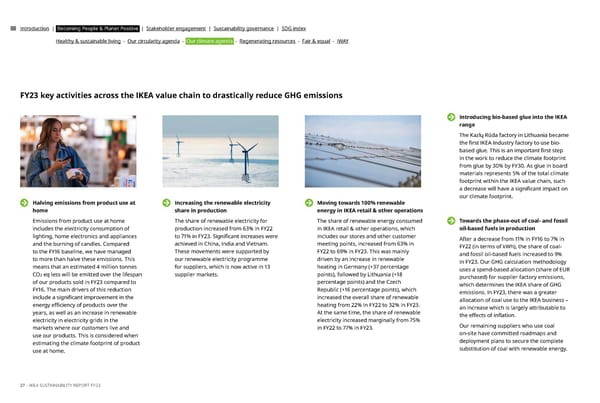Introduction | Becoming People & Planet Positive | Stakeholder engagement | Sustainability governance | SDG index Healthy & sustainable living - Our circularity agenda - Our climate agenda - Regenerating resources - Fair & equal - IWAY FY23 key activities across the IKEA value chain to drastically reduce GHG emissions Introducing bio-based glue into the IKEA range The Kazlų Rūda factory in Lithuania became the 昀椀rst IKEA Industry factory to use bio- based glue. This is an important 昀椀rst step in the work to reduce the climate footprint from glue by 30% by FY30. As glue in board materials represents 5% of the total climate footprint within the IKEA value chain, such a decrease will have a signi昀椀cant impact on our climate footprint. Halving emissions from product use at Increasing the renewable electricity Moving towards 100% renewable home share in production energy in IKEA retail & other operations Emissions from product use at home The share of renewable electricity for The share of renewable energy consumed Towards the phase-out of coal- and fossil includes the electricity consumption of production increased from 63% in FY22 in IKEA retail & other operations, which oil-based fuels in production lighting, home electronics and appliances to 71% in FY23. Signi昀椀cant increases were includes our stores and other customer After a decrease from 11% in FY16 to 7% in and the burning of candles. Compared achieved in China, India and Vietnam. meeting points, increased from 63% in FY22 (in terms of kWh), the share of coal- to the FY16 baseline, we have managed These movements were supported by FY22 to 69% in FY23. This was mainly and fossil oil-based fuels increased to 9% to more than halve these emissions. This our renewable electricity programme driven by an increase in renewable in FY23. Our GHG calculation methodology means that an estimated 4 million tonnes for suppliers, which is now active in 13 heating in Germany (+37 percentage uses a spend-based allocation (share of EUR CO2 eq less will be emitted over the lifespan supplier markets. points), followed by Lithuania (+18 purchased) for supplier factory emissions, of our products sold in FY23 compared to percentage points) and the Czech which determines the IKEA share of GHG FY16. The main drivers of this reduction Republic (+16 percentage points), which emissions. In FY23, there was a greater increased the overall share of renewable include a signi昀椀cant improvement in the allocation of coal use to the IKEA business – heating from 22% in FY22 to 32% in FY23. energy e昀케ciency of products over the an increase which is largely attributable to years, as well as an increase in renewable At the same time, the share of renewable electricity in electricity grids in the electricity increased marginally from 75% the e昀昀ects of in昀氀ation. markets where our customers live and in FY22 to 77% in FY23. Our remaining suppliers who use coal use our products. This is considered when on-site have committed roadmaps and estimating the climate footprint of product deployment plans to secure the complete use at home. substitution of coal with renewable energy. 27 - IKEA SUSTAINABILITY REPORT FY23
 IKEA ESG FY23 Report Page 26 Page 28
IKEA ESG FY23 Report Page 26 Page 28